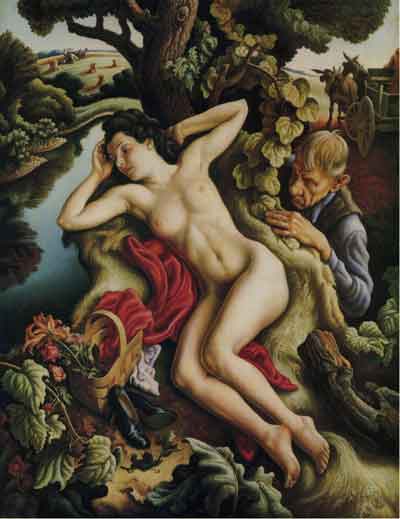Persephone’s abduction by Hades, sometimes Pluto, is rife with sexual predation and seasonal change. In Theogony, Hesiod says that while gathering asphodels with the daughters of Oceanus, Persephone is abducted and taken to Hades, where she rules as the Iron Queen. After much perturbation by her mother, Demeter, Persephone can return to the world for the spring renewal and summer harvests. However, she must return to Hades for fall and winter.
Benton’s Persephone alludes to the myth but discards classical references and suggests a picnic. The setting is rural, perhaps Kansas City, Missouri, where Benton lived at the time. The summery scene offers a picnic, though there is no evidence for one except a wicker filled with flowers.
Persephone is portrayed as a sensual woman like an American pin-up model. alone and naked, is sleeping beneath a great oak. Her wicker basket suggests a picnic, but it is filled with daylilies, a rose, and a carnation, none of which are associated with the mythical Persephone.
The sleeping beauty is unaware that a farmer is peering from behind the tree and is about to reach out and seems to touch her hip. (The alternative title for this painting, s The Rape of Persephone, is seldom used.) Because the farmer resembles Benton, the scene suggests Benton’s personal feelings and sexuality. Perhaps Benton meant this to be a visual pun on his first name, asking viewers to see the farmer as a Peeping Tom.
See Thomas Hart Benton. Persephone (1938), tempera with oil glazes on canvas mounted on panel., Nelson-Atkins Museum of Art Kansas City, MO; http://www.nelson-atkins.org/collections/iscroll-objectview.cfm?id=27583; Hesiod. Theogony (7th Century BCE); http://www2.hn.psu.edu/faculty/jmanis/hesiod/hesiod.pdf

